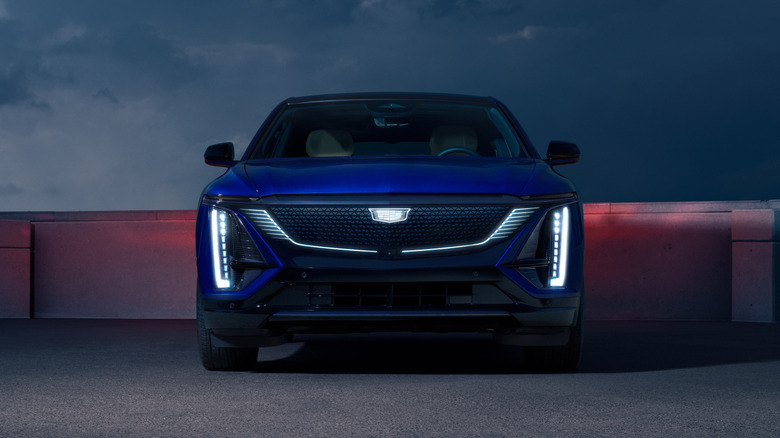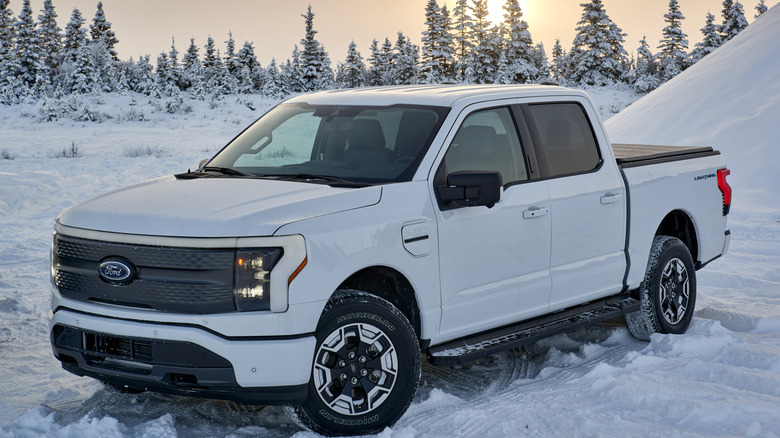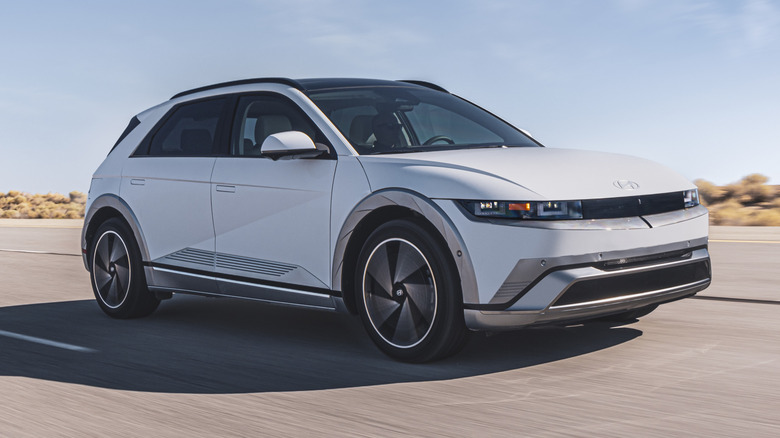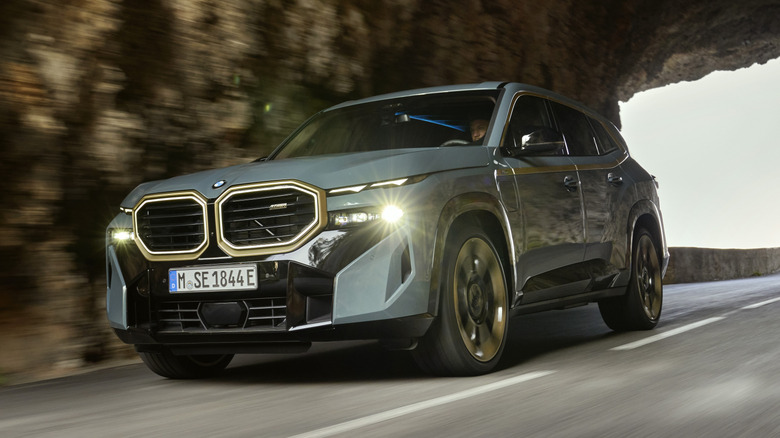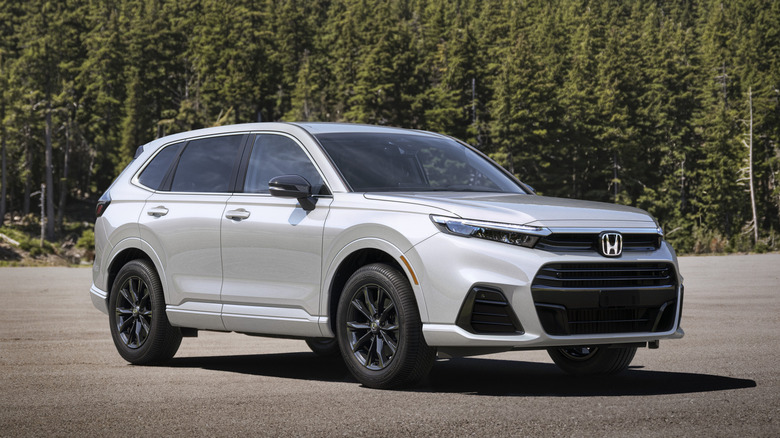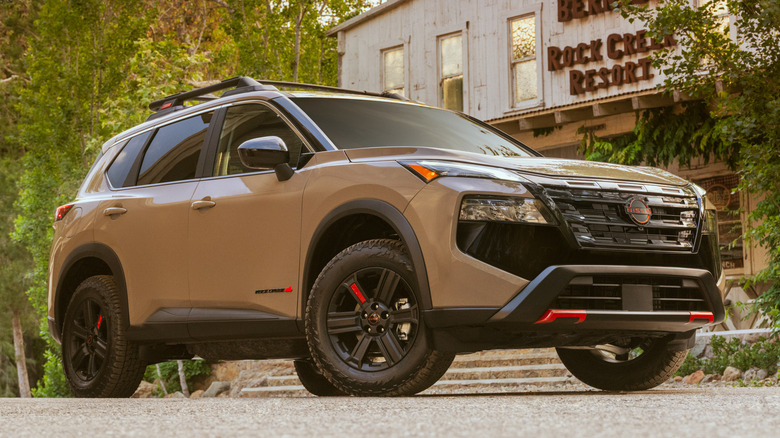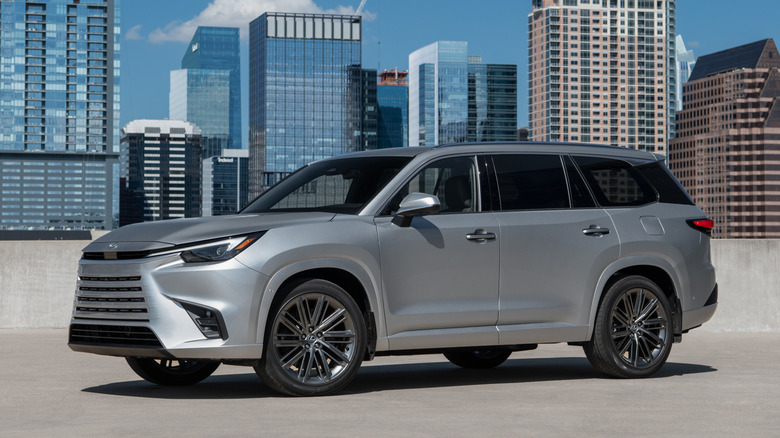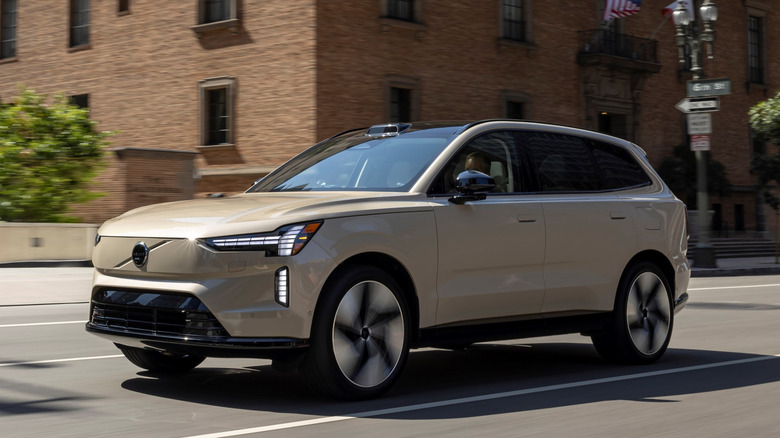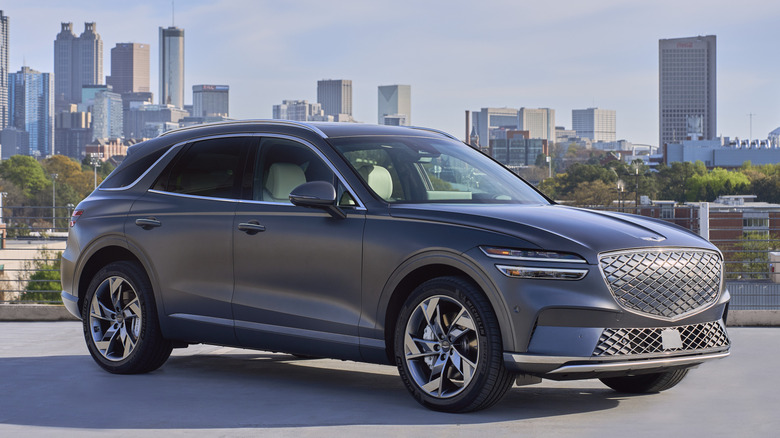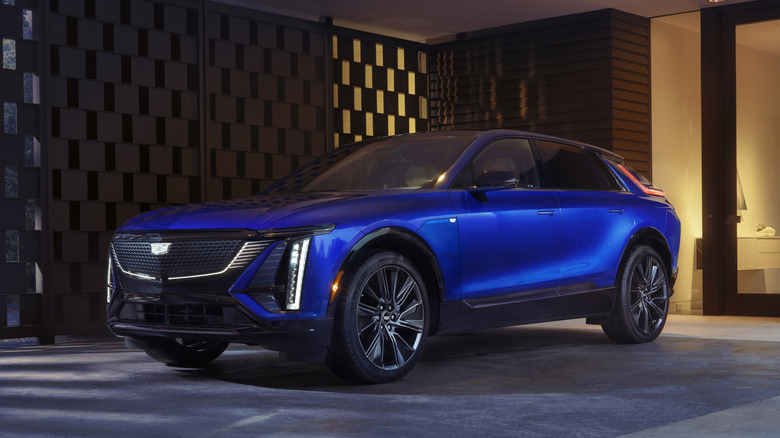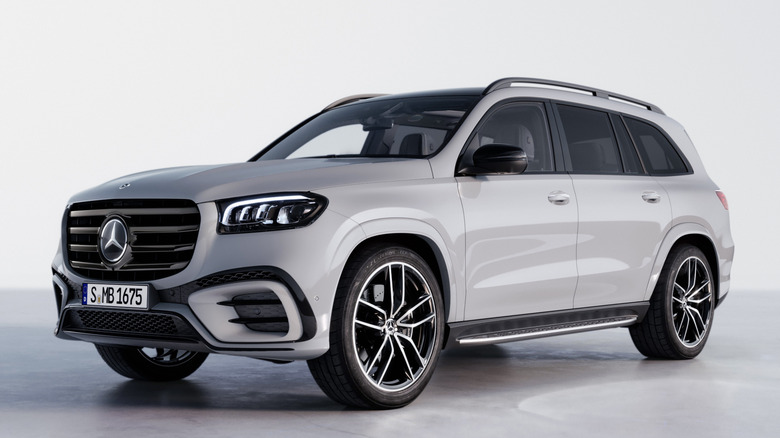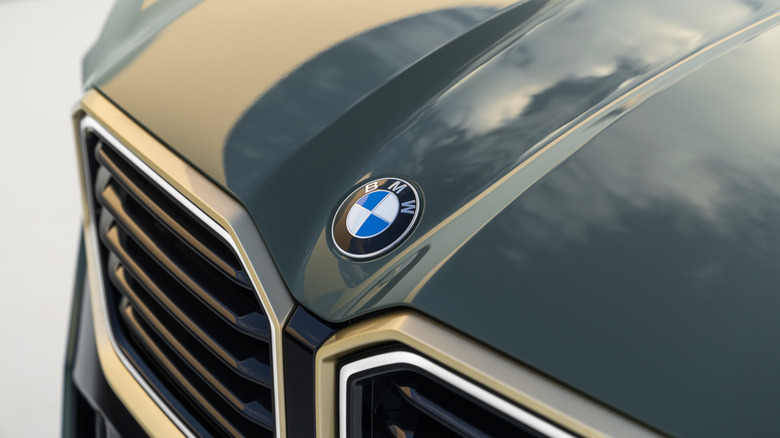10 Of The Least American-Made Cars In 2025
Depending on your priorities, knowing where a car is made and how American it is may be the most important thing in the world — or it may just be a chunk of information that sits alongside other specs of variable importance, such as towing capacity or trunk space. But that's precisely what makes life so interesting. One set of facts that's important to one person can be utterly useless to another. And we're pretty confident that a vehicle's Americanness falls precisely into that category.
Of course, there are now some very practical reasons to want to know how American a particular car is. With tariffs expected to contribute to price hikes for many car brands, a car's country of assembly may be a deciding factor for buyers looking to keep costs low when it comes time to buy a new car. But just because a vehicle is built in America doesn't make it an all-American product. Many domestically assembled vehicles don't use a lot of U.S. or Canadian parts, with some having as little as 10%.
Based on the information automakers disclose as part of the American Automobile Labeling Act (AALA), we've compiled a list of 10 of the least American-made cars on the market in 2025. These are all models assembled in America — no imports — and come from a variety of automakers, including some ostensibly American names.
Ford F-150 Lightning
Let's kick things off with a model that may surprise some of you. The Ford F-150 Lightning, for those of you who've been living under a rock, is the all-singing, all-dancing, all-electric version of Ford's immortal F-150 pickup (which is still as good as ever, if our experience of the 2025 Ford F-150 is anything to go by). The Lightning may have traded the internal combustion engine for fancy electric motors, but the electrified pickup didn't lose any of the original's appeal and was, for a moment, popular enough that Ford had to halt F-150 Lightning production due to high demand.
In fact, the F-150 Lightning's production lines in Dearborn, Michigan, have seen the EV pickup stop and start production numerous times since it first entered production in 2022. There was the aforementioned halt due to high demand, but there have also been less favorable hiccups. A battery issue caused a temporary halt in 2023, while poor sales forced Ford to stop production from mid-November 2024 to early January 2025.
While the F-150 Lightning's spotty production history has directly impacted and involved American workers, it may come as a slight shock to find out that only 29% of the EV pickup comes from American sources. Despite that surprisingly small percentage, the information Ford provides as part of the AALA doesn't reveal any other major sources of components, with the transmission and engine also coming from the U.S.
Hyundai Ioniq 5
Hyundai's Ioniq 5 has been making waves since it debuted for the 2022 model year. Its unique, cutting-edge visual design and enjoyable driving dynamics show that EVs can be just as fun as their internal combustion predecessors. Ioniq 5 sales in the U.S. have climbed year-on-year since release, hitting an impressive 44,000 units in 2024.
In what may yet prove to be a prescient move given President Trump's tariffs, Hyundai announced in June 2024 that it would bring production of the 2025 Ioniq 5 to the U.S., with production slated to take place at the Hyundai Motor Group Metaplant America in Savannah, Georgia. To be clear, Hyundai's execs weren't psychics. The main motivation for Hyundai to move production stateside was to make the Ioniq 5 eligible for federal tax credits, which stipulate that the EV's final assembly has to take place in the U.S. But things look to have worked out nicely for the automaker nonetheless.
Of course, just because a car is made in the U.S. doesn't mean that all — or most — of its parts content comes from American suppliers, and that's precisely the case with the Ioniq 5. Only 29% of the Ioniq 5 comes from America, with 29% and 33% of the components coming from South Korea and Hungary, respectively. It's also worth noting that this only applies to the standard Ioniq 5. The sporty Hyundai Ioniq 5 N is still listed as an import, with final assembly of that model taking place in South Korea.
BMW XM
BMW may be a name associated with high-powered European class and luxury, but the German automaker actually makes a handful of models in the U.S. for global export, including most of its X family of SUVs. The newest member of that American-built family is the BMW XM, which joined the assembly lines at the automaker's Spartanburg, South Carolina, facility in 2022.
The XM is the hottest, burliest member of BMW's SUV lineup and the first M Division-exclusive BMW since the BMW M1, which means that there's no non-M version of this beast. Powered by a 644-horsepower, 590 lb-ft hybridized twin-turbo V8, the XM impressed us during our first drive back in 2023, with our reviewer highlighting the SUV's "outstanding" performance and high-end luxury experience as being particularly praiseworthy. If that wasn't enough, BMW launched the crazy 700-plus-horsepower BMW XM Label Red later that year, also coming out of Spartanburg.
Most of BMW's X-series SUVs use around 30% U.S. or Canadian parts, but the XM falls a bit short of this mark, although admittedly, not by much. AALA data indicates that 26% of the XM's parts are American, with another 26% coming from BMW's home country of Germany. Like the other X SUVs, though, the drivetrain and engine are both sourced from overseas. In the case of the XM, both come from Germany. We're not sure if the same assembly breakdown applies to the XM Label Red, but we imagine the numbers will be quite similar (if not identical), given the shared assembly plant.
Honda CR-V e:FCEV
Honda has had a manufacturing presence in America for many decades, with the first American-assembled Honda car — an Accord — leaving the assembly line of its Marysville, Ohio plant in 1982. Honda has continued to build many of its most popular nameplates in the U.S., with the Accord, Civic Hatchback, and CR-V all coming out of its various American facilities.
One of the newest names to join that illustrious list is the CR-V e:FCEV, which Honda introduced to its Marysville assembly lines in mid-2024. The 2025 Honda CR-V e:FCEV is a car of many firsts. Not only is it the only FCEV assembled in America (according to Honda, at least), it's also the first domestically built hydrogen fuel cell vehicle to use an American-made fuel cell system, which it combines with a plug-in hybrid battery that offers 29 miles of battery-only propulsion.
Like other hydrogen-powered EVs such as the Toyota Mirai, the Honda CR-V e:FCEV is only available for lease in California. That makes for the possibly-unfamiliar situation of an American-made vehicle not being available for sale where it's assembled. But it's at least American-made to some extent, with final assembly in the aforementioned Ohio facility and 25% of the constituent parts coming from the U.S. and Canada. The vast majority — 65% — of the CR-V e:FCEV's components come from Japan, including transmission and engine.
Nissan Rogue
The Honda CR-V e:FCEV kicks off a mini-list of Japanese models, with the next two vehicles also coming from carmakers with origins in the Far East. Up next is the ever-popular Nissan Rogue, which has sold remarkably well since its 2007 debut. That first generation was imported from Japan, but Nissan moved production to its Nissan Smyrna Vehicle Assembly Plant in Tennessee starting with the second generation in 2013.
Nissan made the decision to build the Rogue in the U.S. to keep prices down, as the Japanese Yen was doing particularly well against the U.S. Dollar at that point in time. Assembling the Rogue in America meant that the automaker didn't have to worry about exchange rates forcing an increase in the Rogue's retail pricing. The automaker didn't look back after that and, by 2020, had assembled more than 1.1 million Rogues in Tennessee. Unsurprisingly, Nissan has continued to build the Rogue in Smyrna, with recent iterations like the 2025 Nissan Rogue maintaining Nissan's decent presence in the American crossover SUV market.
Like the Honda CR-V e:FCEV, only 25% of the Rogue's parts come from America. 40% come from Japan, while 15% come from just across the border in Mexico. Unlike the other cars on this list, though, you will also encounter Japanese-made Rogues, although these models have the same component breakdown as the U.S.-assembled versions. The only difference beyond the final country of assembly is that the Smyrna-built Rogues use transmissions sourced from Mexico, while the Japanese-built SUVs use transmissions built in Japan.
Lexus TX 550h+
Rounding off our sequence of cars from Japanese automakers is the Lexus TX 550h+, one of the three versions of the full-size, three-row SUV available in America — the others being the TX 350 and TX 500h. As the numbering may suggest, the 550h+ sits at the pinnacle of the contemporary Lexus TX family, with its 404-horsepower hybrid powertrain and full-on luxury trimmings earning solid praise from our very own Victoria Scott when she drove all three TX models in 2023.
Lexus produces its vehicles in several plants across America and Japan, with the TX models — gasoline, hybrid, and PHEV — coming exclusively from the Toyota Motor Manufacturing Indiana (TMMI) plant, located in Princeton, Indiana. Of the Lexus TX models available in the U.S., the 550h+ is by far the least American of the bunch: Whereas the lower-end TX 350 and TX 500h use 65% and 45% American parts, respectively, the premium 550h+ lags behind with only 25% of the three-row SUV built using American components.
Unsurprisingly, 65% of the TX 550h+ comes from Japanese sources, and Toyota sources both the engine and transmission from its home base in Japan. That's the price you pay for that signature Lexus luxury, perhaps — although 25% is still plenty compared to some of the other vehicles we're going to look at soon.
Volvo EX90
Volvo may have backtracked slightly on its goal to be all-EV by 2030, but vehicles like the new Volvo EX90 show that the company is still very much committed to an electrified future — and to bringing some of its production and assembly to the United States. Originally meant to enter production in 2023, the first examples of the electrified SUV for the U.S. market began leaving the production lines of Volvo's Charleston, South Carolina factory in 2024.
This spiritual successor to the gasoline XC90 quietly impressed reviewers on its debut, earning plaudits for its refined driving experience and high-quality materials, even if some of the tech, such as the built-in LIDAR system and bi-directional charging, wasn't quite ready for use at launch. That didn't stop the EX90 from selling reasonably well, though, with just over 1,300 units sold as of April 2025. Not quite setting sales charts on fire, admittedly, but it's one of the best-selling Volvos after the popular XC range of gasoline-powered SUVs.
Volvo offers two trim levels for the EX90, Plus and Ultra, with owners also able to choose between the standard 402-horsepower drivetrain and the perkier 510-horsepower Performance electric drivetrain. Interestingly, component sourcing differs between the EX90 Plus and Ultra. The former has 20% American parts, while the Ultra bumps that up slightly to 25%. Both versions get a combined 60% of their parts from Mexico and China, while the engine and transmissions come directly from Sweden. Volvo also builds the EX90 in China and Europe.
Genesis Electrified GV70
We enter the top — or is it bottom? — three with a second entry from Korean automotive giant Hyundai, this time under the Genesis brand, which it spun off back in 2015. The model in question is the Electrified GV70, which first broke cover in 2021 and made its way to the U.S. market for the 2023 model year.
The Electrified GV70 was the Korean brand's third-ever EV, following an EV version of the G80 and a dedicated electric SUV called the GV60, both of which came out in 2021. But while the Electrified GV70 wasn't the first electrified Genesis to hit dealer forecourts, it was a landmark for Genesis in two other (related) aspects. More specifically, the Electrified GV70 was the first Genesis built outside of South Korea and the first Genesis to be assembled in the U.S.
Genesis builds the GV70 in both its Electrified and gas-guzzling forms in Hyundai's facility in Montgomery, Alabama, where it shares time on the assembly lines with Hyundai offerings like the Tucson, Santa Fe, and the stylish Santa Cruz ute. It's worth noting that the Electrified and petrol GV70s have a slightly different ratio of American to non-American parts: the GV70 has a decent 25%, with 70% of its components from Korea. The Electrified GV70 drops to 17% American, with a larger 80% of its constituent components coming from Korea.
Cadillac Lyriq
Cadillac joins Ford as the only other American brand on this list with the Lyriq, its fancy electric luxury SUV that impressed us quite a bit when we tested it earlier this year. The Lyriq is one of a handful of GM EVs with surprisingly little in the way of American-sourced components, although it's the only one of the bunch — which includes the Chevy Blazer EV and Chevy Equinox EV — assembled in the U.S., which is why it's the only one that makes it onto this list.
As you might expect from its position at the tail-end of our list, the Cadillac Lyriq has much less American content than its compatriot, the Ford F-150 Lightning. More specifically, American components only make up 12% of the parts used in the Lyriq. 46% comes from Mexico, while 20% makes its way to the EV from Korea. GM, of course, has quite a sizable presence in Korea and sells the Lyriq in the Asian nation, which likely goes some way to explaining the use of Korean components. Interestingly, the AALA data doesn't disclose where GM sources the powertrain and transmission for the Lyriq.
The Lyriq is one of the handful of electric luxury SUVs built on GM's Ultium platform, sharing the EV architecture with the aforementioned Chevy Blazer EV and, perhaps somewhat surprisingly, the Acura ZDX — which, despite the brand's links to Honda, is actually 55% American, at least according to AALA data.
Mercedes-Benz GLE, GLS, and EQS
Finally, we come to the unenviable task of naming the least American-made car you can buy in 2025 — at least, based on the data we have access to. Say hello to the Mercedes-Benz GLE, GLS, and EQS vehicles, all of which are only 10% American despite coming out of Mercedes-Benz's long-running Mercedes-Benz U.S. International facility in Alabama.
Built initially to supply M-Class Mercedes-Benz SUVs to American buyers in the late 1990s, the MBUSI factory has continued to build cars for the German marque in the years since, including for global export. Chief amongst these models are the automaker's EQS, GLE, and GLS vehicles, such as the hybrid-powered 2024 Mercedes-Benz GLE and GLS 580 4Matic. The AALA lists an impressive 14 Mercedes-Benz vehicles from the aforementioned product lines, all of which have the unfortunate honor of only using 10% American components. The other significant source of components — including the engines and transmissions — is, as you might expect, Germany, which contributes 25% of the parts.
There are plenty of vehicles on the list that use less than 10%, but none of those are assembled in the U.S. That gives these Mercedes-Benz models the dubious honor of topping our list of the least American-made cars you can buy. Does it make them bad vehicles? Not in the least. But this just goes to show that there's a lot more to a car's heritage than simply where it's assembled.
Our methodology
As we briefly discussed in the introduction, the core of this list is the information that all automakers have to provide as part of the American Automobile Labeling Act, which was enacted in 1992. The act requires manufacturers to disclose the percentage of U.S. or Canadian parts that go into a particular product line, as well as the main foreign sources of parts (if present). This information is presented to the consumer as a sticker affixed to the car, but is also available online.
The sticker also goes into more detail, showing where the final assembly of each individual car took place, any secondary countries involved in the final assembly, plus the countries of origin for the engine and transmission. Congress passed the law to clarify manufacturers' claims of domestic assembly, better allowing consumers to "buy American," as a slogan of the time proclaimed. The sticker may or may not have helped steer car buyers in that direction. Still, either way, it has meant that all cars sold in America since then have had this production information readily available to buyers and industry observers alike, allowing us to put this list together.
Finally, it's also worth repeating that we limited ourselves to cars assembled in the U.S. Imports, after all, aren't American-made, so you'd expect them to have very little in the way of U.S. or Canadian content to begin with.
